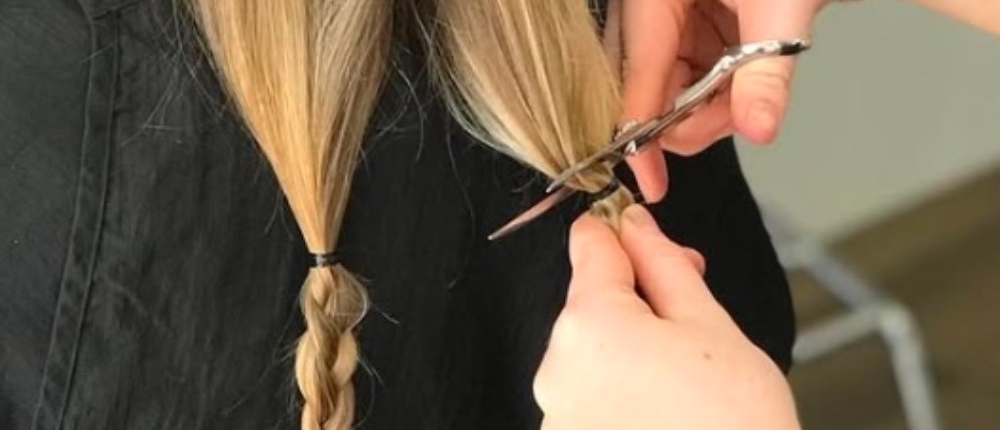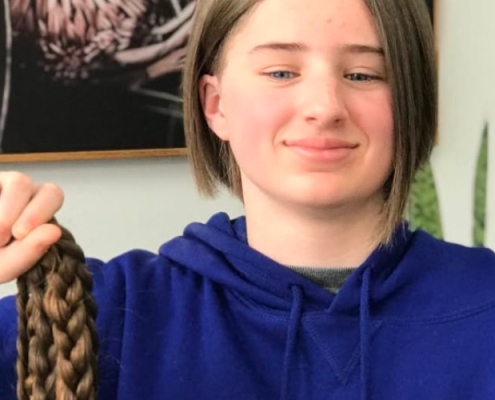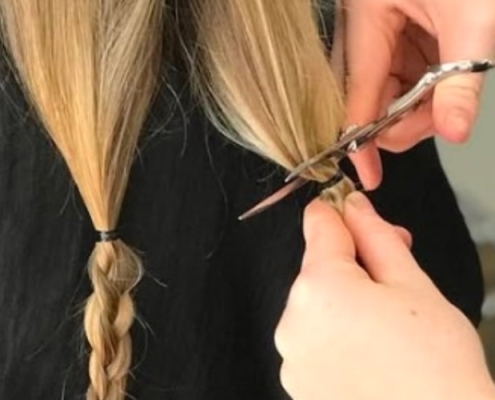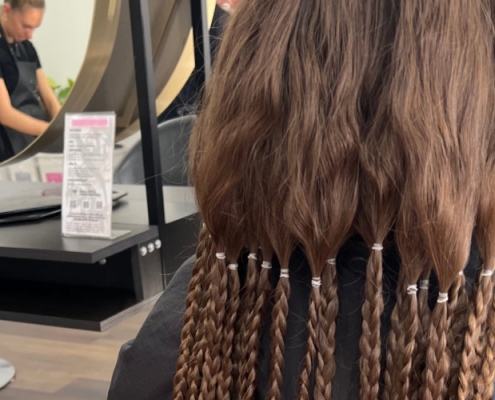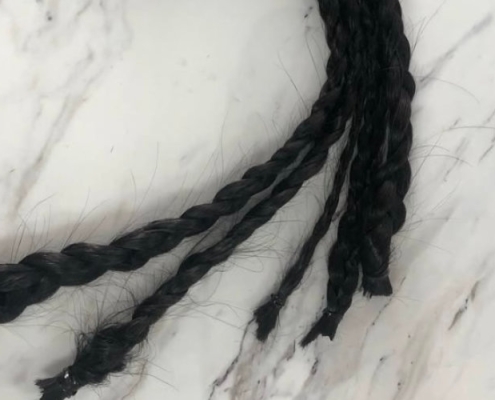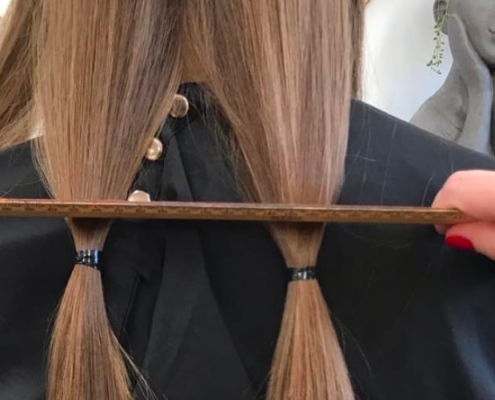Ponytail Donation vs. Synthetic Wigs: Which Helps More?
When considering ways to help individuals experiencing hair loss due to medical conditions such as cancer or alopecia, many people wonder whether donating a ponytail or supporting synthetic wigs is the better option. While both play a role in providing solutions, natural hair wigs and synthetic wigs have significant differences in their quality, durability, and impact on recipients.
In this article, we’ll compare the benefits and limitations of ponytail donations versus synthetic wigs to help you understand how each contributes to individuals in need.
What Are Ponytail Donations Used For?
Ponytail donations are collected by various charities and organisations that create **natural human hair wigs** for individuals experiencing hair loss. These wigs are specially handcrafted to provide a realistic and comfortable alternative to synthetic wigs.
How Donated Hair Is Used
- Sorting and Processing: Once hair is donated, it is cleaned, sorted by colour and texture, and prepared for wig-making.
- Handcrafted Wigs: Skilled wigmakers use donated hair to create high-quality, durable wigs that mimic natural hair growth.
- Personalised for Recipients: Many natural wigs are custom-fitted and styled to match the recipient’s preferences.
To learn more about what happens after you donate your hair, read: What Happens to Your Hair After You Donate It?.
What Are Synthetic Wigs?
Synthetic wigs are made from artificial fibres such as polyester, acrylic, or modacrylic, designed to resemble natural hair. These wigs are mass-produced and often come pre-styled, requiring little maintenance.
Key Features of Synthetic Wigs
- Affordability: Synthetic wigs are typically cheaper than human hair wigs.
- Pre-Styled: They hold their shape and style even after washing.
- Low Maintenance: Unlike human hair wigs, synthetic wigs do not require frequent styling or heat treatments.
Comparing Ponytail Donations and Synthetic Wigs
Both natural hair wigs (made from ponytail donations) and synthetic wigs serve an important role in providing hair solutions for individuals experiencing hair loss. However, they have significant differences in terms of quality, comfort, durability, and impact. Below is an in-depth comparison of the two.
1. Quality and Appearance
The appearance of a wig is one of the most important factors for recipients, as they want a natural look that closely resembles their real hair.
- Human Hair Wigs: Wigs made from donated ponytails offer **the most realistic appearance**. They move and behave like real hair, adapting to different lighting conditions and environmental factors naturally. Because human hair has natural variations in texture and colour, these wigs create a more **authentic and seamless blend** with the recipient’s scalp and facial features.
- Synthetic Wigs: Many synthetic wigs are made with high-quality fibres designed to mimic human hair, but they often have an **unnatural shine** that makes them look less realistic. While premium synthetic wigs are improving in appearance, they still lack the **softness and fluid movement** of real hair.
2. Comfort and Breathability
Comfort is a major consideration, especially for individuals who wear wigs daily due to medical hair loss.
- Human Hair Wigs: Because they are made from real hair, these wigs offer **superior breathability**, preventing excessive sweating and scalp irritation. Many are hand-tied onto a lightweight lace or mesh cap, making them comfortable to wear for extended periods.
- Synthetic Wigs: These wigs are typically made with heat-resistant plastic fibres, which can feel **hot and uncomfortable**—especially in warm climates. Synthetic wig caps are often less breathable, leading to **itchiness and scalp discomfort** for some wearers.
3. Durability and Longevity
One of the biggest differences between human hair wigs and synthetic wigs is how long they last with regular use.
- Human Hair Wigs: With proper care, **human hair wigs last between 2 to 3 years**. They can withstand regular washing, styling, and even hair treatments. This makes them a **long-term solution** for individuals experiencing hair loss.
- Synthetic Wigs: Synthetic wigs typically **last only 4 to 6 months** before they start to frizz and lose their shape. The fibres cannot be restyled or repaired in the same way that human hair can, meaning they need to be replaced more frequently.
4. Styling Versatility
For many recipients, the ability to style their wig is a crucial factor in feeling confident and comfortable in their appearance.
- Human Hair Wigs: These wigs can be **washed, curled, straightened, coloured, and restyled** just like natural hair. Wearers have the freedom to change their look based on their personal preferences, helping them feel more like themselves.
- Synthetic Wigs: Most synthetic wigs come **pre-styled** and cannot be altered. Heat-resistant synthetic wigs exist, but they have **limited styling options** compared to real hair wigs.
5. Cost and Affordability
The cost of wigs varies depending on the material, craftsmanship, and production method.
- Human Hair Wigs: Because they require **handmade craftsmanship** and take time to construct, human hair wigs are **significantly more expensive** than synthetic wigs. Prices can range from **$500 to $3,000+ AUD** per wig.
- Synthetic Wigs: These wigs are **mass-produced** and more affordable, with prices typically ranging from **$50 to $500 AUD** depending on quality.
6. Maintenance and Upkeep
Each type of wig requires different levels of care to maintain its condition.
- Human Hair Wigs: Just like natural hair, these wigs require **regular washing, conditioning, and styling** to keep them looking fresh. They need to be carefully stored when not in use and may require occasional professional maintenance.
- Synthetic Wigs: These wigs require **less daily maintenance** since they hold their shape and style even after washing. However, they do not last as long and need replacing more frequently.
7. Sensory and Emotional Impact
For individuals experiencing hair loss, receiving a wig is not just about appearance—it’s also about regaining confidence and a sense of normalcy.
- Human Hair Wigs: Many recipients of human hair wigs report feeling **more confident and emotionally supported**, as these wigs provide the closest experience to having their natural hair back. Being able to style and wear a wig that feels real can be incredibly empowering.
- Synthetic Wigs: While synthetic wigs provide an affordable solution, some recipients find them **less emotionally comforting** due to their unnatural look and feel.
Which Option Helps More?
Both synthetic wigs and human hair wigs have their place, but if the goal is to provide recipients with **a long-term, natural-looking, and emotionally uplifting solution**, human hair wigs made from ponytail donations are the superior choice.
While synthetic wigs offer a quick and affordable option, they lack **the realism, durability, and personalisation** that human hair wigs provide. For someone experiencing long-term hair loss, a high-quality human hair wig can be **life-changing**.
If you’re considering donating your ponytail, you can learn more about the impact of hair donations here: Why Hair Donations Matter: Supporting Cancer and Alopecia Patients.
How to Donate Your Ponytail
If you’ve decided that donating your hair is the right choice, follow these steps:
- Ensure your hair meets the required length and condition. Check the full requirements here: Who Can Donate Hair? Requirements and Guidelines.
- Grow and maintain healthy hair to make sure your donation is in the best condition. Get tips here: Growing Your Hair for Donation: Tips for Healthy Growth.
- Book an appointment with a participating hairdresser. Read the full donation process: How to Donate Your Ponytail: A Step-by-Step Guide.
Final Thoughts
While synthetic wigs offer convenience and affordability, natural hair wigs made from donated ponytails provide a superior option for individuals experiencing hair loss. If you want to make a lasting impact, consider donating your ponytail to help create high-quality wigs for those in need.
To start your donation journey, visit our service page: Ponytail Donations.

